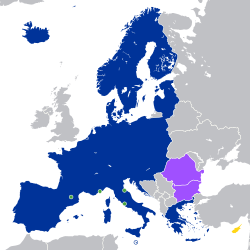Schengen Area | |
|---|---|
 Map of the Schengen Area
Schengen Area
Schengen Area
(air and maritime borders only) Countries with open borders to the Schengen area
Member of the EU committed by treaty to join the Schengen Area in the future | |
| Type | Open border area of the European Union |
| Members | |
| Establishment | 26 March 1995 |
| Area | |
• Total | 4,595,131 km2 (1,774,190 sq mi) |
| Population | |
• 2021 estimate | 453,324,255 |
• Density | 98.7/km2 (255.6/sq mi) |
| GDP (PPP) | 2023 estimate |
• Total | |
• Per capita | |
| GDP (nominal) | 2023 estimate |
• Total | |
• Per capita | |
| This article is part of a series on |
 |
|---|
|
|
The Schengen Area (English: /ˈʃɛŋən/ SHENG-ən, Luxembourgish: [ˈʃæŋən] ) is an area encompassing 29 European countries that have officially abolished border controls at their mutual borders. Being an element within the wider area of freedom, security and justice policy of the European Union (EU), it mostly functions as a single jurisdiction under a common visa policy for international travel purposes. The area is named after the 1985 Schengen Agreement and the 1990 Schengen Convention, both signed in Schengen, Luxembourg.
Of the 27 EU member states, 25 are part of the Schengen Area. Bulgaria and Romania, the newest members of the Schengen Area since March 2024, only have air and maritime borders open, with land border controls remaining in place pending agreement to lift them. The only EU member states that are not part of the Schengen Area are Cyprus and Ireland. Cyprus is legally obliged to join in the future, while Ireland maintains an opt-out and operates its own visa policy. Denmark also maintains an opt-out from the wider AFSJ policy area, but has adopted the Schengen acquis on an intergovernmental basis. Denmark does not have voting powers for introductions and revocations of measures applied to the Schengen area as a result of this opt-out.[2]
In addition to the member states of the European Union, all member states of the European Free Trade Association, namely Iceland, Liechtenstein, Norway and Switzerland, have signed association agreements with the EU to be part of the Schengen Area. Moreover, the territory of four microstates – Andorra,[3] Monaco, San Marino and Vatican City – is de facto included in the Schengen Area due to their small size and difficulty of maintaining active border controls.[4]
The Schengen Area has a population of more than 450 million people and an area of 4,595,131 square kilometres (1,774,190 sq mi). About 1.7 million people commute to work across an internal European border each day, and in some regions these people constitute up to a third of the workforce. In 2015, there were 1.3 billion crossings of Schengen borders in total. Fifty-seven million crossings were due to transport of goods by road, with a value of €2.8 trillion.[5][6][7] The decrease in the cost of trade due to Schengen varies from 0.42% to 1.59% depending on geography, trade partners, and other factors. Countries outside of the Schengen Area also benefit.[8] States in the Schengen Area have strengthened border controls with non-Schengen countries.[9]
Cite error: There are <ref group=lower-alpha> tags or {{efn}} templates on this page, but the references will not show without a {{reflist|group=lower-alpha}} template or {{notelist}} template (see the help page).
- ^ a b "World Economic Outlook Database, October 2023". IMF.org. International Monetary Fund. Retrieved 31 March 2024.
- ^ "Schengen, your gateway to free movement in Europe" (PDF). Council of the European Union.
- ^ "Schengener Übereinkommen". auswaertiges-amt.de (in German). German Ministry of Foreign Affairs. Retrieved 2 June 2024.
- ^ "Tourist, Student and Work visa to Europe". Swift Tourism. 2010. Archived from the original on 5 September 2017. Retrieved 14 September 2011.[dead link]
- ^ Cite error: The named reference
europarlwas invoked but never defined (see the help page). - ^ European Council on Foreign Relations (2016). "The Future of Schengen". Retrieved 15 June 2017.
- ^ "Schengen's economic impact: Putting up barriers". The Economist. 6 February 2016. Retrieved 15 June 2017.
- ^ Cite error: The named reference
CEPRwas invoked but never defined (see the help page). - ^ "The refugee crisis: Fixing Schengen is not enough". Retrieved 14 December 2018.



